Leveraging additive manufacturing for end-user race car parts
LEVERAGING ADDITIVE MANUFACTURING FOR END-USER RACE CAR PARTS
Introduction
The Formula SAE racing competition was founded in 1979 by engineering professors in the United States. The competition was designed to inspire and challenge students automotive design and engineering abilities, as well as how to work as a team. In 1999, the competition expanded to Europe and was not long until several European universities started to join.
The racing series is a success, with hundreds of teams scattered over the globe and new ones joining every year. The concept of letting students design their own racing car and gather some real experience is also attractive for future potential employers, and many former Formula Student members work in leading positions of companies.
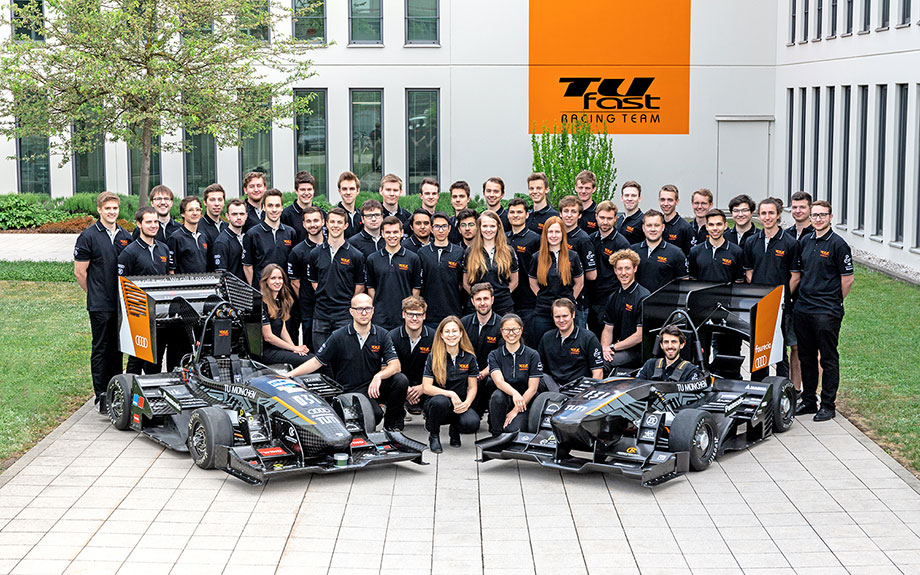
2018's TUfast Team © TUfast Racing Team
One such group was founded at the Technical University of Munich. TUfast started off as a student initiative in November of 2002. The five founding members of TUfast felt that practical experience was missing from their mostly theoretical studies. By establishing the TUfast team, students learned about working under time pressure, with a monetary limit, teamwork, and effective communication.
Technology innovations have pushed the design capabilities of the automotive industry and the designs generated by the TUfast team are no exception. This year’s team has taken advantage of additive manufacturing (AM) to help improve their design. With help from GKN Powder Metallurgy, the TUfast team could upgrade their car’s design using AM to construct a more energy efficient vehicle.
Building Upon Previous Designs
The basic idea of the Formula SAE is to design a race car according to the official FSAE rules. Every team can only enter a vehicle once in each of the competitions – each year the team must build a new car. Taking part in the competition is a complex undertaking. Even the best car fails without proper financing or when the fabrication process takes too long, which will eliminate the car from the competitions.
The competitions are composed of races and the best overall package of performance, engineering design, cost, and presentation.
The dynamic events make up the driving disciplines:
- Skidpad (Lateral acceleration, 50pts)
- Acceleration (75pts)
- Autocross (1 lap sprints, 150pts)
- Endurance (22km long racing distance with driver swap, 300pts)
- Efficiency (Comparison of fuel-/energy efficiency, 100pts)
During the static events, the car will be inspected by experienced engineers in the following disciplines:
- Engineering design (150pts)
- Cost report (100pts)
- Business plan (75pts)
The sheer mass of different disciplines calls for general knowledge in various different fields. Only the most successful teams in all of the disciplines have what it takes to win a formula student competition.
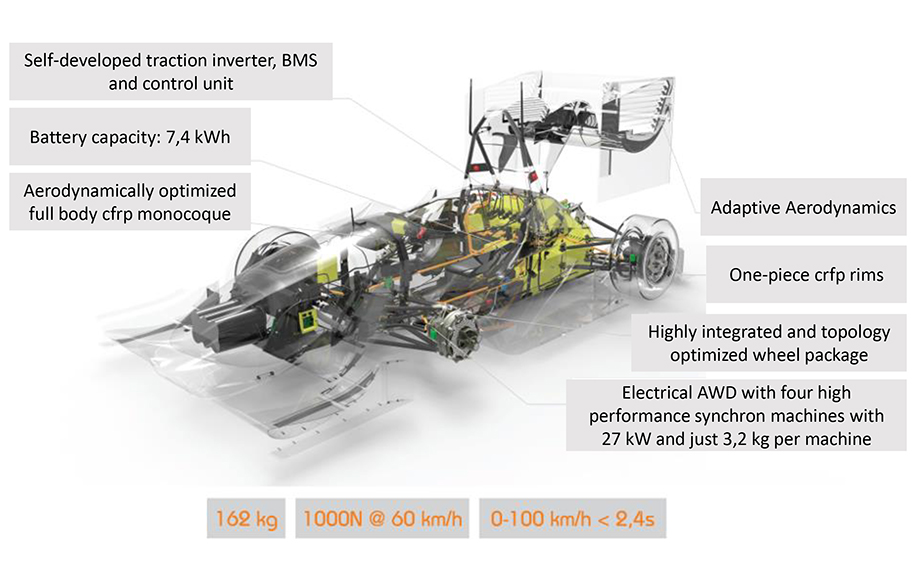
2017's TUfast Team’s car design © TUfast Racing Team
In 2017 TUfast’s vehicle was an electric all-wheel drive with four high performance synchronized motors each 27 kW and 3.2 kilograms. The battery capacity was 7.4 kWh. The car also had a self-developed traction inverter, a battery management system, and a control unit. The vehicle had a one-piece carbon fiber reinforced polymer (CFRP) rim, adaptive aerodynamics, and an aerodynamically optimized monocoque body.
One area of the vehicle that underperformed was the E-machine cooling of the wheel hub drive. In the 2017 design, the small power-dense motor had a cooling system integrated into the upright that did not operate sufficient, limiting the team's ability to race and endurance points. The cooling structure was inefficient.
The structure surrounds the motor in the wheel hub to prevent it from overheating. The mass flow into the previous cooling system was 150 g/s with an inlet temperature of 40 grads and a heat flow of 1,000 watts. When calculating the pressure across the system, the TUfast assumed a stationary, incompressible, and adiabatic calculation, along with SST K-Omega turbulence model with smooth walls. The fluid going through the system was ideal, but the pressure drop across the system was high. The pressure level at its highest read 1.00e + 04 and would drop to 4.00e + 03. In total, the pressure drop was 24,200 Pascals with an average inner surface temperature of 44.43℃. The system resulted in a poor heat transfer and an uneven temperature distribution.
The TUfast set out to build a better cooling system for the E-machine of the wheel hub drive. TUfast turned to GKN Powder Metallurgy and the additive manufacturing (AM) process. By using AM, the metal housing can be designed small enough to fit precisely into the wheel hub, while having a complex inner lying cooling structure to improve the cooling.
How AM helps to produce end-user race car parts
To help achieve a more efficient performing vehicle, the automotive market has entered the additive manufacturing space. Additive manufacturing brings a natural competitive advantage for time-to-market contraction of new ideas and for the development of innovative solutions. AM is used for the prototyping of parts, to ensure fit and function. The process has also been used to mass manufacture parts that require a unique shape that would be impossible to achieve via traditional machining.
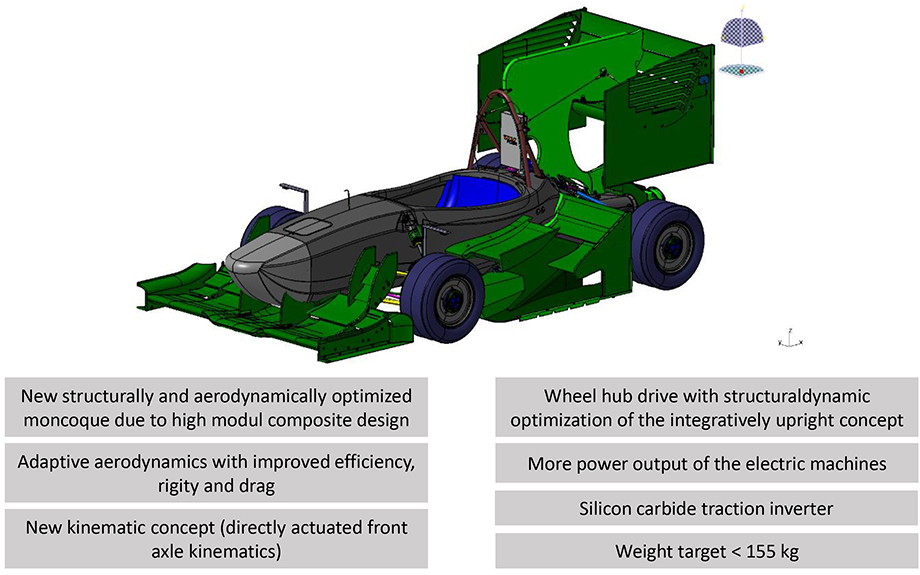
2018 TUfast Team's car design © TUfast Racing Team
The TUfast team used AM to design a whole cooling system for the wheel hub drive in 2018. The team focused on making the wheel package lightweight and small. Next, the team used topology optimization to reduce the weight of the upright. The AM laser sintered aluminum body of the E-machine with the new integrated cooling structure is the centerpiece of the powertrain. In recent years, it has been a turned part that resulted in a less complex but also less effective cooling.
To enhance the cooling performance, a new design concept was used with an integrated structure. Integrating inner cooling channels directly into the housing of the structure is only possible with AM, or more precisely, laser sintering is the only process that makes it possible to manufacture this component.
Results
In an additive process, a designer only uses as much material as necessary. This not only reduces the weight of parts but also material waste and print times. The TUfast racing team utilized design software to create topologically-optimized parts and were able to reduce the weight by 0.6 kg.
The CFD optimized laser sintered cooling geometry increased the performance and efficiency of the E-machine cooling by almost 25%. This was possible by a reduction of the pressure loss in the cooler of the E-Machine and a larger contact surface between the hot machine and the cooling fluid. The pressure loss in the E-machine was reduced by 5 times. This leads to an increased cooling mass flow of 27%. The increased cooling mass flow has not only an advantage on the cooling performance of the E-Machine also the other components, like the radiator and the cooler of the inverter take benefit.
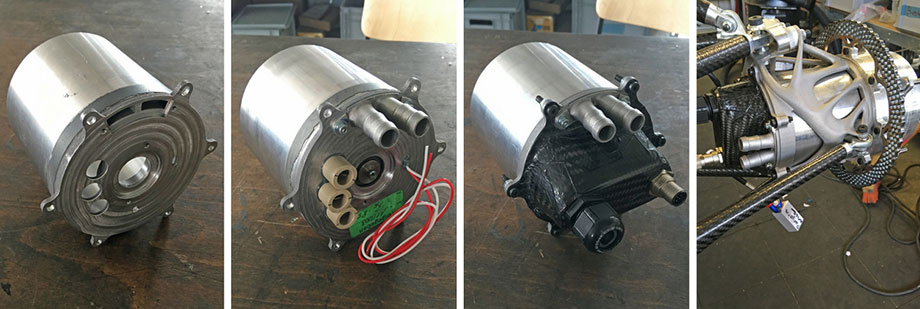
Step-by-step assembly of the wheel-hub-drive / © TUfast Racing Team
Finding the right Additive Manufacturing Partner
Responsible Team Member for the E-machine, Marco Tönjes, illustrates how GKN was the ideal partner for the new design. “GKN is a well-known name in the market. It made sense for us to seek out their expertise. They helped us to further optimize the housing. We originally wanted to implement the adapter for the cooling connections as an integral part of the housing. However, GKN's engineers had a different approach. They suggested that we should separate the housing and connection adapter, as this significantly reduces the support structure required for production. The adapter, which is also laser-sintered by the additive business of GKN Powder Metallurgy, is now mounted to the housing by screwing.”
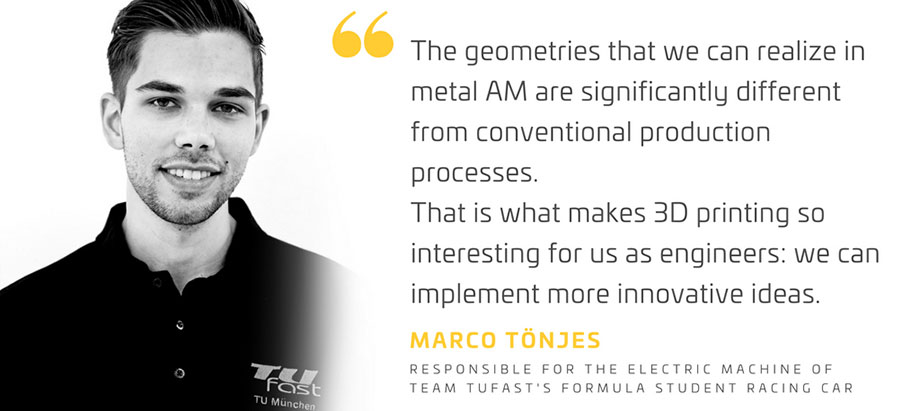
Marco Tönjes is responsible for the electric machine of the Team TUfast's racing car / © TUfast Racing Team
Students like the ones from team TUfast and companies such as GKN Powder Metallurgy are already finding solutions and leading the charge on a new revolution in AM in the automotive industry. This knowledge is positioning themselves for a successful future by finding innovative ways to stay agile and efficient in a changing industry.


